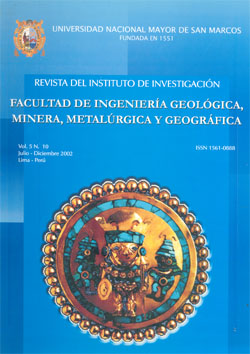Oxidized lead mineral flotation
DOI:
https://doi.org/10.15381/iigeo.v5i10.757Keywords:
oxidized lead minerals, crystallography, flotation properties, thermodynamics, cation collectors, oxide flotationAbstract
The main oxidized lead minerals are: cerussite and anglesite, which due to their crystallography and wettability should not be buoyant, for this reason it is necessary to study the flotation properties for these minerals, the main ones are: solubility, surface physico-chemical , thermodynamics, fines content and others, it is concluded that anglesite is less buoyant than cerussite, both can be floated directly with amyl xanthate: long-chain hydrocarbon collector and cationic collectors such as alamine 26-D. The flotation of oxides improves when they are previously sulfurized before adding xanthate type collector, obtaining economically acceptable results. The above is applied to a polymetallic mineral of galena, sphalerite and cerussite; up to four flow charts are discussed, two are experimented, and with the bulk flotation scheme Pb-Zn, followed by flotation of oxides, after sulfurization with sodium sulfide excellent results are obtained, taking into account the complexity of the mineral.
Downloads
Published
Issue
Section
License
Copyright (c) 2002 Angel Azañero Ortiz, Pablo Antonio Núñez Jara, Aquiles Figueroa Loli, Elard León Delgado, Sósimo Fernández Salinas, Roberto Orihuela Salazar, Manuel Caballero Ríos, Robinson Bazán Reyes, Sergio Yi Choy Aragón

This work is licensed under a Creative Commons Attribution-NonCommercial-ShareAlike 4.0 International License.
AUTHORS RETAIN THEIR RIGHTS:
a. Authors retain their trade mark rights and patent, and also on any process or procedure described in the article.
b. Authors retain their right to share, copy, distribute, perform and publicly communicate their article (eg, to place their article in an institutional repository or publish it in a book), with an acknowledgment of its initial publication in the Rev. Inst. investig. Fac. minas metal cienc. geogr.
c. Authors retain theirs right to make a subsequent publication of their work, to use the article or any part thereof (eg a compilation of his papers, lecture notes, thesis, or a book), always indicating the source of publication (the originator of the work, journal, volume, number and date).






